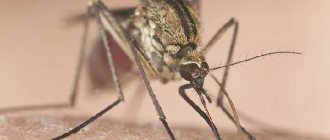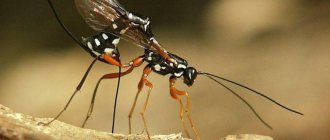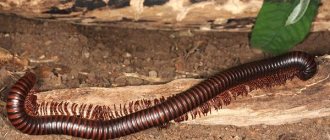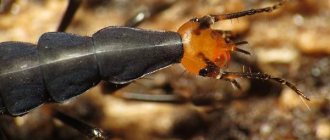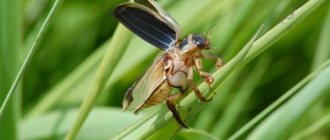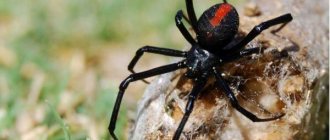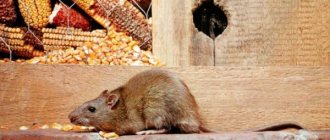- Wild animals
- >>
- Mammals
The shrew (Sorex) is a small insectivorous animal from the shrew family. They live on all continents in the northern hemisphere, mainly in forests and tundra. This genus includes the winners in the categories “smallest” and “most voracious” among mammals. They challenge Bergman's law and demonstrate the Danel effect. In total there are about 70 species in the genus, of which 15–17 species are in Russia.
Origin of the species and description
Photo: Shrew
The Latin name of the genus comes from a word meaning “whisper, chirp, buzz.” This refers to the sounds that animals make during collisions with each other. The Russian name of the genus is given for the reddish-brown color of the tops of the teeth.
The types are distinguished based on the structure of the teeth, which is quite difficult for a non-specialist. The taxonomy is poorly developed; today there are different classifications, according to one of them there are three subgroups.
Video: Shrew
But according to another - four:
- species of unknown origin, including the tiny shrew (Sorex minutissimus) - indeed, the tiniest mammal in Russia and the second in the world, smaller than only the dwarf shrew (multi-toothed shrew) from the same shrews;
- subgenus Sorex, which includes the common shrew, also known as the shrew (Sorex araneus) - the most common and typical representative of the genus and the most numerous mammal of northern Europe;
- subgenus Ognevia with the only, but largest, representative - the giant shrew (Sorex mirabilis);
- The subgenus Otisorex includes mainly North American species and the smallest native mammal, the American pygmy shrew (Sorex hoyi).
The fossils date back to the Upper Eocene, the time when modern orders of mammals appeared.
Some types
Shrews are a whole subfamily. There are more than 70 species. There are a few of the most common ones:
- common or forest, an animal common in thickets;
- tiny or Chersky, the smallest representative up to 4 grams;
- Tibetan, similar to ordinary, but living in mountainous areas;
- Bukhara, a high-mountain animal of light brown color with a tassel on the tail;
- medium, the white-bellied variety, lives mainly on the islands;
- giant, one of the rare representatives of the Red Book;
- small, small shrew, brown-gray with full fur.
Appearance and features
Photo: What does a shrew look like?
At first glance, the animals look like mice, but they belong to a completely different order - insectivores. Upon closer examination, the body structure is noticeably different from that of a mouse. First of all, the relatively large head with a muzzle elongated into a flexible proboscis catches the eye. The animal constantly moves it, sniffing and looking for prey. The ears are tiny and practically do not protrude from the fur. The eyes are microscopic and completely expressionless.
If we consider them a mirror of the soul, then the shrew has almost no soul - all the animal’s thoughts are only about its daily bread. But such small animals cannot do otherwise, they lose too much heat compared to large ones, they constantly require energy replenishment of metabolic processes, which go on at breakneck speed. “The less weight, the more food” is a general rule for all warm-blooded animals. Babies have 32 teeth, like a human, but the incisors, especially the lower ones, are very long. Milk teeth are replaced by permanent ones even in the embryo, so that the animal is born fully equipped with all teeth.
The body length (without tail) in different species can range from 4 cm in a tiny shrew to 10 cm in a giant shrew; weight ranges from 1.2 - 4 g to 14 g, respectively. The average size, for example, of a common shrew is 6–9 cm plus a tail of 3–5.5 cm. The body is covered with velvety thick fur sticking out vertically, so the shrew cannot be stroked against the grain. The color of the fur on the upper side is reddish, brownish or grayish and camouflages the animal well on the ground; on the lower side the body is light gray.
The tail can be either very short or almost equal to the body, covered with sparse hairs. There are usually glands on the sides and base of the tail that secrete a pungently smelling musky secretion that protects the shrew from predators. Females have from 6 to 10 nipples. In males, the testes are located inside the body, and the copulatory organ can reach 2/3 of the body length.
Interesting fact: The shrew's skull is like an elongated triangle - it has a greatly expanded brain section and narrows towards the nose, so that the jaws look like tweezers. By winter, the skull decreases, reducing the volume of the brain, and in summer it increases (the so-called “Danel effect”). The brain makes up 10% of the weight of the entire animal and this ratio is greater than that of a human or even a dolphin. Apparently, the constant need to solve problems with food contributes to brain development.
Description of the shrew
Externally, shrews resemble mice. The length of their elongated body is 6-8 cm, weight is about 8-15 g, the tail is relatively long from 3 to 5 cm. The head is a cone-shaped head, ending with a thin long movable proboscis, the teeth are brown or reddish. On the sides and back the fur is thick, velvety, brownish or dark brown in color, the belly is light gray. The ears look like small flaps that protrude slightly above the fur.
Where does the shrew live?
Photo: Shrew in Russia
The range of the genus covers mainly the subarctic and temperate zones of all continents of the northern hemisphere. In more southern regions, such as Central America or Central Asia, shrews are found in the highlands.
A typical representative, the common shrew, is the most versatile and adapted to life in a wide variety of natural zones from the northern tundra to the lowland steppes, where it chooses floodplains and tall grass meadows for settlement. The animals do not like open places and cannot tolerate direct sunlight - their favorite habitats are always shady and damp. In winter they live under a layer of snow, practically never coming to the surface.
In central Russia, common shrews are found everywhere in forests and parks, especially cluttered ones, with dense undergrowth and a thick layer of forest litter. They live along the banks of stagnant bodies of water in thickets of coastal vegetation, near swamps. But they are also common in cultivated summer cottages, which is confirmed by cats bringing them as prey. They are especially drawn to human habitation on the eve of winter, when they can even climb into houses.
Interesting fact: The smallest species live in the tundra and highlands and endure the fierce frosts of central Siberia, although it would seem they should strive for warm places. Moreover, studies of the American ash shrew (Sorex cinereus) have shown that the body size of the animals decreases the further north they live. This contradicts Bergmann's well-known rule, according to which the size of individuals in cold areas of the range should increase.
Now you know where the shrew is found. Let's see what this animal eats.
Shrew distribution
The shrew is found throughout Eurasia from the shores of the Pacific to the Atlantic Ocean, south to Palestine and to Siberia in the north.
— Advertising —
The animal lives in various areas, but always in damp and shady areas. Lives in forests, parks, meadows. In cold seasons, it enters populated areas and hides in storerooms and cellars.
What does a shrew eat?
Photo: Shrew from the Red Book
When searching for food, shrews are guided by a keen sense of smell and keen hearing; some species use echolocation. Animal food, as the most high-calorie food, forms the basis of the diet. The shrew eats everything it can catch and chew with its exceptionally sharp teeth - needles.
It can be:
- any insects at all stages of development, Coleoptera, Diptera and Lepidoptera, with more larvae being eaten;
- spiders;
- earthworms;
- mollusks, including slugs, to which shrews owe worms;
- other invertebrates; for example, nods, which are eaten by the giant shrew;
- baby mouse-like rodents;
- small amphibians;
- carrion, such as a bird or mouse;
- in extreme cases, he engages in cannibalism, even eating his own children;
- in winter it consumes plant foods, in particular coniferous seeds, which can make up up to half of the diet;
- also eats mushrooms and droppings.
In search of food, it makes narrow branched passages in the snow. The amount of food eaten per day is 2 to 4 times more than the weight of the animal itself.
Feeding characteristics of shrews
— Advertising —
Shrews are carnivorous mammals. They spend almost all their time searching for food. They cannot live even three hours without food. This is due to intense metabolism and rapid digestion of food.
The shrew's diet includes earthworms, insect larvae and pupae, butterflies, and dragonflies. In addition, it also hunts animals such as mouse-like rodents and frogs. In winter, the food is monotonous, since under the snow in the unfrozen soil layer the shrew can only find wintering insects. Once in cellars and pantries, the shrew never touches food supplies; it only looks for insects.
Plant food can serve as a supplement to the shrew's main diet, especially in winter, for example, seeds of spruce and pine cones, linden nuts.
Features of character and lifestyle
Photo: Common shrew
Our closest neighbor in the natural world is the most studied - the common shrew. Using her example, let's look at how these animals live and what they do. The shrew is agile and agile. Despite her weak legs, she cheerfully makes her way through the grass and loose forest floor, snoops under fallen bark and brushwood, can climb tree butts, swim and jump. She does not dig holes, but uses other people's underground passages, not being interested in the owner's opinion. The greedy baby is driven by the demands of the stomach and death from hunger is more real for her than from the teeth of a predator. Without food, it dies within 7 - 9 hours, and smaller species - after 5.
The animal spends more than half of its time, 66.5%, in motion and continuously searching for food. After eating, he sleeps, and after sleeping, he goes in search of food and such cycles during the day can be from 9 to 15, the slightest delay in this cycle will cost him his life. During the search, he covers up to 2.5 km per day. When food supplies are depleted, it moves to other places.
In autumn, and especially in winter, the shrew reduces activity, but does not hibernate. The baby simply cannot accumulate enough reserves for wintering and is forced to spin around even in frosty weather. It's amazing that she even survives until spring. Molting occurs in April - May and September - October, like all inhabitants of places with a seasonal climate. In winter, the skin becomes lighter. The sounds can be identified as squeaking, chirping or thin chirping. They are emitted mainly during a meeting and the fight that follows it.
Interesting fact: The tiny shrew eats 120 times every 10 to 50 minutes during the day. However, it lives in a colder zone of Eurasia than the common shrew.
Shrew behavior
Shrews are typical loners. They move into burrows one by one. In the construction and arrangement of burrows, they can safely be called lazy, since they love to occupy ready-made shelters that once belonged to other shrews. There they leave offspring, which consist of 2-10 cubs, approximately 3 times a year. Pregnancy lasts about 30 days.
In total, there are about 70 species of shrews in the genus.
The shrew is characterized by making paths in the litter, consisting of grass and leaves fallen from trees. Typically, particular activity occurs closer to night, 3 hours before sunset; shrews emerge from their burrows in search of food. Life expectancy is only 2 years.
https://www.youtube.com/watch?v=3IL9Xdqxf1Y
If you find an error, please select a piece of text and press Ctrl+Enter.
Social structure and reproduction
Photo: Baby shrew
Shrews do not live together and when they meet, they show aggression, attacking each other screaming and emitting their signature smell. The male and female unite only for a short moment to mate, which in the common shrew can occur 3 or 4 times from April to October.
After the meeting, the female finds an old stump, hummock, trunk, empty hole or pile of brushwood and makes a nest from hay, moss or leaves. The nest is round with a cavity 8-10 cm in diameter. After about three weeks, the female gives birth to (3)6 – 8(11) children. The weight of the cub is about 0.5 g, length is less than 2 cm, it does not see, lacks hair and even a proboscis. But after 22–25 days, the new generation is completely ready for independent life, and the female is ready for new reproduction.
The young become sexually mature the following year, although the first spring litter is capable of breeding after three or four months. The rush is quite justified - super active animals live no more than 2 years. Which is common to all representatives of the genus.
Interesting fact: If the nest is in danger, the mother and young cubs of some species (common shrew, ashen shrew) form so-called “caravans” - the first child grabs the mother by the base of the tail, the rest similarly cling to each other. This is how they move around in search of safe shelter. There is another opinion that they are exploring the surrounding area, conducting “nature excursions,” so to speak.
Reproduction of shrews
Shrews build nests in the top layer of soil, stumps or old burrows of other species from dry parts of herbaceous plants, and line them with moss on the inside.
The breeding season begins at the end of March and continues throughout the warm season. Females produce 2-3 broods, 7-8 babies in each. Pregnancy lasts 18-28 days. Shrews are born helpless, naked, blind, but they grow quickly and already at the age of 1 month they feed like adults.
Life expectancy is about 1.5 years.
Natural enemies of shrews
Photo: Gray shrew
Everyone has enemies, even such angry and foul-smelling little ones. Some simply kill them, while others may even eat them if they do not have a good sense of smell.
This:
- mammalian predators, including domestic cats, which usually abandon their prey without eating it;
- owls that eat them despite the smell;
- hawks and other diurnal predators;
- storks;
- vipers and other snakes;
- predatory fish grab swimming animals;
- the shrews themselves are dangerous to each other;
- Parasites (helminths, fleas, etc.) cause a lot of harm to health.
Shrews usually coexist peacefully with people, although of course they can come under attack during terrorist attacks against mice and rats. However, people cause the greatest harm indirectly - by changing the environment through deforestation and urban development, and using pesticides.
Interesting fact: When studying one of the populations of the common shrew, 15 species of helminths belonging to round and flatworms were found in the tiny ones. One individual contained 497 different worms. Here is a typical example of harmony in nature!
Characteristic
The tiny shrew is one of the smallest insectivorous creatures in Russia and Europe. The size of an adult individual including the tail is 6-7 cm, and the weight does not exceed five grams. It would be more correct to describe the tiny shrew with the silky fur of a soft coffee color on the back, which turns into light fluff on the belly. The tail, which is slightly more than half the length of the shrew's body, is also two-colored. The paws are not covered with fur.
In summer, the color of the animal fades slightly, and in winter it becomes richer. The animal's ears are small, but hearing is very well developed, as is touch and sense of smell. The elongated head ends in a proboscis nose with bristling vibrissae (long whiskers).
Shrews do not live more than a year and a half, and approximately a fifth of this short life is spent during their breeding season. Unlike most animals, the female's gestation period is not strictly fixed. The cubs will be born healthy in both 18 and 28 days. The average number of babies per litter is about five, but sometimes there are 8. During her life, an adult female gives birth to from 1 to two litters.
Population and species status
Photo: What does a shrew look like?
Population sizes of different species vary greatly. The most numerous and common species of Eurasia, the common shrew, can have a population of 200 - 600 specimens per hectare. The more food and hidden places for shelter, the greater the population density. Similar Eurasian ranges are found in the small, tiny, even-toothed shrews and many others. Large and densely populated habitats covering tundra and forest zones are characteristic of many American species.
Some species are more local, such as the Caucasian shrew, which inhabits the forests of the Caucasus and Transcaucasia, or the Kamchatka shrew from Kamchatka and the coast of the Sea of Okhotsk. But very rare ones, few in number and found in a small area, are not so common. Different countries have their own rarities.
The regional Red Books of Russia include:
- the tiny shrew (S. minutissimus) is protected in the Moscow, Ryazan, Tver, and Kaluga regions;
- the clawed shrew (S. unguiculatus) and the slender-nosed shrew (Sorex gracillimus) are included in the Red Book of the Amur Region;
- Radde's shrew (S. raddei) in the CC of a number of North Caucasian republics;
- The small shrew (S. minutus) is a Crimean rarity. Just in case, it is also included in the Red Book of Moscow as an indicator of forests preserved in an undisturbed state. Although in general the species is not threatened;
- The equal-toothed shrew (S. isodon) is protected in the Moscow region and Karelia. The range covers the forest zone of Eurasia from Scandinavia to the Pacific Ocean.
Common types of shrews
- Common shrew or common shrew or wood shrew (Sorex araneus)
Body length 55-82 mm, weight from 4 to 16 g. Tail 60-75 mm long.
The body is dark brown on top, almost black-brown, the abdomen is light. The young are light brown. The tail is bare or slightly pubescent. The ears are almost invisible. The muzzle is narrow, elongated. The species is distributed in northern Europe in dense grassy thickets, forest undergrowth, bush thickets, and heather heaths.
- Tiny shrew or Chersky's shrew (Sorex minutissimus)
The smallest species with a body length of 4-5 cm, a tail length of 2.5-3 cm. Weight is about 4 g. The head is wide and large, ending with a short proboscis.
The eyes and ears are small. The fur is short, velvety, dark brown or brown on the back and gray or silvery-white on the belly. The tail is also dark above and light below. The species is found in the west from the Scandinavian Peninsula to Japan and Sakhalin in the east.
- Tibetan shrew (Sorex thibetanus)
The body length is 51-64 mm, the tail is 32-54 mm long. Outwardly similar to an ordinary shrew.
The species was discovered in China, in the provinces of Qinghai, Sichuan and Gansu.
- Bukhara shrew (Sorex buchariensis)
Body length 55-69 mm. The tail is 42-50 mm long with a tassel at the tip. The back is painted sandy brown or light brown. The belly is light gray. The head is elongated and narrow.
The species' habitat includes Uzbekistan, Tajikistan, and Kyrgyzstan, where it lives in high-mountain birch and poplar forests.
- Medium shrew (Sorex caecutiens)
Body length is from 58 to 77 mm, tail length is 36-42 mm, weight is 4-8.5 g. The back and sides are brown to dark gray, the belly is grayish-white.
Distributed from Finland, northern Sweden and Norway to the Anadyr River basin. Also found on Sakhalin (Russia) and Hokkaido (Japan), in Korea.
- Gansu shrew (Sorex cansulus)
Body length 62-64 mm, tail 38-43 mm long. The back is grayish-brown, the belly is reddish-fawn. The tail is dark brown above, light below.
A rare species that lives in the south of the Chinese province of Gansu.
Large-toothed shrew or dark-toothed shrew or dark-toothed shrew or dark-toothed shrew or large-toothed shrew (Sorex daphaenodon)
Body length is 61-71 mm, weight reaches 9.5 g. The proboscis is short. The back is dark brown or black, the sides are light, and the belly is dark gray. The tail is brown.
Distributed from the Urals to Sakhalin.
- Giant shrew (Sorex mirabilis)
One of the largest species with a body length of up to 10 cm and a weight of about 14 g. The body is brownish-brown in color, the belly is lighter and dull.
Muzzle with long light gray whiskers. Endemic to the Far East, where it lives in the south of the Primorsky Territory, northeast China and the north of the Korean Peninsula. Listed in the Red Book of Russia.
- Equal-toothed shrew (Sorex isodon)
Body size is average. The fur color is dark, monochromatic, the fifth upper intermediate tooth is brightly pigmented.
It is found in the taiga of Eurasia from the Scandinavian Peninsula and Belarus to the Pacific coast. Included in the Red Books of the Republic of Karelia and the Moscow Region.
- Kozlov's shrew or Tibetan mountain shrew (Sorex kozlovi)
Body length is about 41 mm, tail length up to 33 mm. Summer fur is long, fluffy, silky. The tail is pubescent with a tassel at the tip. The back is chocolate-brown in color, the sides are light, the belly is white with a fawn coating.
A rare species, was discovered in Tibet.
- Little shrew or small shrew or little shrew (Sorex minutus)
Body length 43-64 mm, tail length 31-46 mm.
Weight from 2.5 to 7.5 g. The back is brown-gray or reddish-coffee. The belly is grayish-white, rarely yellowish-fawn. Winter fur is darker. The hair on the tail is thick and long. The proboscis is sharp, elongated. Distributed in Europe, the European part of Russia, in the west and south of Siberia, in Kyrgyzstan.
- Clawed shrew (Sorex unguiculatus)
Outwardly it resembles a common shrew.
Body weight reaches 20 g, body length 54-97 mm, tail length 40-53 mm. Lives in China, Japan, Russia.
- Kamchatka shrew (Sorex camtschatica)
Body length is about 57 mm, tail 54 mm long.
Weight about 5 g. The back is earthy-gray, the sides are light, brown or fawn. The belly is light gray. The hind foot is very elongated. The species is distributed in the northeast of Siberia, in Kamchatka.
- Masked shrew (Sorex cinereus)
The body length reaches 9 cm, including 4 cm of tail length, weight up to 5 g. The fur is gray-brown on top, light gray below, the muzzle is pointed. The tail is brown above, lighter below, and the tip is dark.
Found in Canada and the USA.
- Long-tailed shrew (Sorex dispar)
The medium-sized shrew is gray in color with a light belly, a pointed muzzle and a long tail.
It lives in North America, in the forests of Canada and the USA.
- Little shrew (Sorex hoyi)
Body length is up to 5 cm, tail is about 2 cm, weight is 2-2.5 g. The fur is gray-brown or red-brown, the belly is light.
In winter, the fur turns gray. This is the smallest mammal in North America, lives in Canada and the USA, in coniferous and deciduous forests.
- Paramushir or Beringian shrew (Sorex leucogaster)
Outwardly it resembles an ordinary shrew.
It is endemic to Paramushir Island (Kuril Islands).
- Marsh shrew or water shrew (Sorex palustris)
Body length up to 15 cm, tail length about 8 cm, weight up to 13 g. The back is dark gray, the belly is light.
Found in Canada and the USA.
Green Way
Shrew (Sorex minutissimus)
When thinking about the answer to the question about the most voracious animal, the imagination immediately begins to picture a ferocious tiger or lion tormenting its prey, or a huge elephant eating branches from trees, but many will probably be surprised that the most voracious mammal is the tiny shrew - one one of the smallest creatures on Earth.
The shrew is very easy to confuse with a mouse. It is distinguished by a long, elongated muzzle, the tip of which looks like a short proboscis. And the main difference is that the mouse is a rodent, and the shrew is an insectivorous mammal. There is no harm from the shrew, but the benefit is very great: it eats insects, including many pests.
Despite its small size, the shrew is very voracious. It feeds mainly on small soft insects, worms, larvae, slugs, woodlice and spiders, and small beetles. When it is very hungry, the shrew can attack small vertebrates: frogs, lizards, young small rodents. In winter, its diet also includes seeds. The list of pests that the shrew eats looks quite impressive: slugs, mole crickets, May beetles, click beetles, leaf beetles, weevils, moth caterpillars and cutworms. Shrews also eat useful animals - small frogs.
In Russia, shrews are distributed from Moscow to Japan and Sakhalin. That is, the tiny shrew and its relatives also live here in Primorye and other regions of the south of the Far East - Khabarovsk Territory, Amur Region and Sakhalin. They are found in various biotopes: deciduous and mixed forests, taiga, tundra, in floodplains and along lake shores. In the taiga zone, the number of shrews is usually 200-600 per hectare, in the tundra - 3-5 times less.
The shrew's muzzle is elongated and trunk-shaped. The skull is large and the facial region is long. The eye beads are black, round, small. The dimensions are small, only 3-4 cm with a weight of up to 2 g (the only exception is the giant shrew (18 cm and 200 g)). The wool pile is short, thick, velvety to the touch. Color ranges from brown to fawn, with a constant light belly. The tail is half or more of the length of the body.
Varieties of shrews. There are approximately 260 species of in the world . The animals are distributed all over the world, except for the North Pole (this is understandable) and Australia (this is not clear). On the territory of the Russian Federation, 21 species are officially registered . The most common: Dwarf shrew . A tiny body no more than 4.5 cm is usually gray-brownish, less often smoky. The tail is decorated with fine guard hairs. Among the rows of sharp teeth, large white front incisors stand out clearly. The popular name in Europe is the Etruscan shrew or the little shrew. The largest concentration of the animal is in European mountainous regions. Long-tailed shrew (house shrew). Among shrews, it is already considered a large specimen (up to 6-7 cm) with a grayish-brown color. Chersky's shrew (tiny). It is the smallest mammal in the Russian fauna. In our country, they live in Primorye, in the Oryol region and about. Sakhalin. Outside Russia there are on the Scandinavian Peninsula, Kazakhstan, and the Japanese Islands.
One can only envy the appetite of all representatives of the shrew family - they are always chewing something. Judge for yourself, the tiny shrew is the smallest mammal of the fauna of the Russian Federation with a body length of 30-53 mm and a weight of 1.5 - 3 g. During the day, this little one “lunches” 121 times ! And she eats more than 10 g of food, which is four times her own weight! In total, in summer, the entire population of shrews living on 1 hectare eats from 5 to 20 kg of various insects per month, and 102–210 kg per year. Imagine how much these insects would eat and ruin in your garden if it were not for shrews. In winter , the need for food increases significantly, and the shrew, in order not to die from the cold and retain heat in its body, is forced to eat about 30 g of food per day. That is 14 times its own weight!
The smaller the shrew, the more periods of sleeping and feeding there are during the day. Thus, for the tiny shrew, the day is divided into 78 intervals. Seventy-eight times he sleeps and wakes up the same number of times to get food for himself.
Some species of shrews cannot survive without food for more than 7 hours and, if there is no food, the animals die. Its gluttony is explained by its small size. In order for this small body to maintain a constant temperature (after all, the shrew is a warm-blooded animal, like all mammals), active digestion processes with the release of heat must constantly occur in it. The shrew's body is characterized by a very high metabolic rate and energy activity. The heart of a small, tireless animal beats at a speed of 700, and when frightened, up to 1200 beats per minute!
Energy is needed not only for heating, but also for movement. Therefore, the shrew is simply doomed to constantly search for food, which it does day and night all day long with short rest breaks. The hunting day of the shrew is 12.5-16 hours.
It will not be possible to keep shrews at home in a limited space; they constantly need to move quickly and over long distances.
The shrew has a weak nervous system. A strong shock, even a thunderclap somewhere high in the skies can kill an animal; a sharp increase in heart rate leads to heart rupture.
The body of shrews is adapted for very rapid digestion of food with the release of large amounts of heat. Their body does not accumulate fat and therefore does not hibernate. A very intense metabolism allows shrews to live in extremely harsh conditions in the cold northern regions.
In winter, the shrew is forced to hunt, making its winding passages under the snow and looking for its victims hiding in dead grass. In total, according to scientists, in the winter months, shrews living on 1 hectare eat 11-40 kg of various insects per month. It is not so easy for a small shrew to rake snow and frozen litter with its weak paws, especially since most of the insects that serve as its food huddle in deep, unfrozen soil horizons for the winter. True, they can be reached through mouse and mole passages, which the shrew actively uses. But still, in winter they have such a hard time that most of them die, and in the spring only 1-4 individuals per hectare remain.
Shrews have very small eyes and they are sometimes covered with fluffs of fur, so their vision is poor. How then do the animals hunt? In search of food, they have to rely mainly on their keen hearing and keen sense of smell. Each shrew has its own hunting area, the size of which, of course, is small - only a few tens of square meters. And the animal steadfastly protects him from the encroachment of his neighbors.
They have several litters , each of which contains from 5 to 10 cubs . The cubs are very helpless and very small, for example, in the little shrew, all 10 of her cubs will not weigh a weight of one gram. However, after two and a half weeks, the babies grow so much that they dare to leave the nest on their own.
baby shrews line up in a train behind their mother to move around in search of food
At the same time, all the cubs line up on the train! Each one carefully holds onto the fur of the one in front with its teeth, and the other one holds on to the mother. You can find videos of such movements on YouTube, very funny!
Need I say how many benefits these animals bring? Meanwhile, they are dying in huge numbers, because they have dangerous enemies . No, not predatory animals (the strong musky smell emitted by shrews scares away predators) - people who destroy shrews simply out of mischief or mistaking them for mice. But the lifespan of these animals is already very short - a shrew lives for a maximum of one and a half years.


